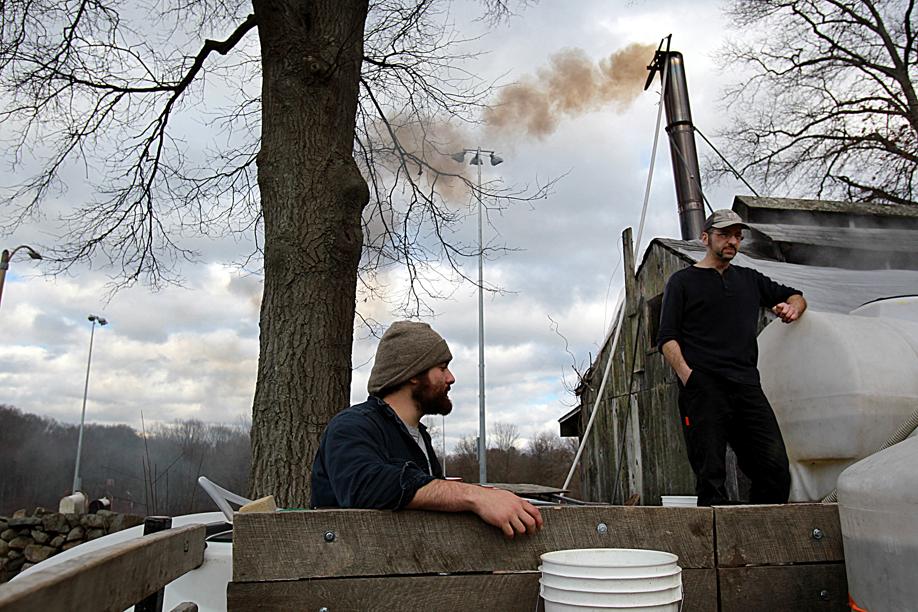

Sweet news for maple syrup lovers: Sugar shacks are firing up as Massachusetts producers get an early start tapping trees this year, thanks to a cycle of warm days and cool nights that began in early February.
At Moose Hill Wildlife Sanctuary in Sharon, workers had collected 1,260 gallons of sap and produced 22 gallons of syrup as of Thursday. It’s a similar story at Natick Community Organic Farm, whose members collected 620 gallons of sap on a single morning.
“It’s going great,’’ said Mathew Noiseux, the property manager at Moose Hill, who predicted that the syrup and other maple products made at the wildlife sanctuary would be sold out by the time the annual maple festival — held March 13, 19, and 20 — concludes.
Of course, it’s still too early to tell how productive the season is going to be. Only Mother Nature can say for sure. But as Governor Charlie Baker kicked off Massachusetts Maple Month, farmers were optimistic.
“We’re further along than we’ve been in the last few years,’’ said Winton Pitcoff coordinator of the Massachusetts Maple Producers Association, based in Plainfield. “We have a jump-start this year, fresh syrup in the barrels. But we’re by no means done.’’
Maple producers put little faith in weather predictions. They don’t gauge the season based on the previous year’s yield. Nor do they predict the current season or weather patterns. Because when it comes to maple sugar production, everyone knows who’s in charge.
Last year, for example, both the ground and trees were frozen solid in early March, and the snow was so deep it was difficult to reach the trees. But by the end of the month, the sap was flowing — and farmers were busy boiling the fluid into large quantities of syrup. Statewide, according to the Massachusetts Maple Producers Association, producers made 75,000 gallons.
By contrast, this year’s mild temperatures and absence of snow have been a boon. Sap production depends on a pattern of cold nights and warm days. If the temperature hovers around 40 or climbs higher during the day but drops to the 30s or lower at night, the trees will produce. What’s necessary, the experts say, are fluctuations in temperature. Warm days and warm nights would stop production in its tracks.
Pitcoff, the state trade association spokesman, says 75 percent of the state’s maple production is centered in the Pioneer Valley and its surrounding hill towns, communities rich in sugar maples, good soil, and a favorable climate.
But sugaring operations are going on near Boston as well. In addition to the Natick farm and Moose Hill in Sharon, there is Drumlin Farm Wildlife Sanctuary in Lincoln, which holds its Sap-to-Syrup Farmer’s Breakfast on March 12 and 13, and some smaller operations.
At Natick Community Organic Farm, signs of spring were in the air even before the first trees were tapped during February school vacation. Baby piglets snuggled inside the barn, and seedlings were sprouting in the greenhouses.
“It’s running a little watery,’’ farm administrator Trish Wesley Umbrell said, describing the sap run on a day in late February after a night of heavy rain and wind. “That said, we boil regardless. We’re at it for days and days and days.’’
It generally takes 40 gallons of sap to produce a gallon of syrup. But the early run in Natick, produced using old-fashioned methods, was low in sugar, so the ratio was raised to 50:1.
Larger maple producers take advantage of technologies that use computers to increase production and efficiency. In Natick and at other small farms near Boston, the preferred sugaring method is the traditional one: buckets tapped to trees; sap transported to the sugarhouse; boiling done on wood-fired evaporators.
“It takes a lot of attention, stoking [the fire], monitoring the temperature, a practiced eye to do it well,’’ said Umbrell.
Last year, Natick farm staff clambered through many feet of snow to reach the sugar maples on the farm, and tapping was late. This year, workers can drive to the taps, a much easier proposition.
But like Pitcoff and others, Umbrell said there is no way to predict how the season will turn out.
“You literally have to make sap when the weather cooperates,’’ she said.
But it’s not just the sweet syrup and maple candy that make the season magical, said Kay Andberg, school program coordinator and camp director at Moose Hill Wildlife Sanctuary.
Walking in the woods late last month, Andberg said, she felt the breeze brush her cheek, listened to the birds singing, and spotted skunk cabbage, spring’s first flower, emerging from the muddy earth.
“You can smell the maple sap in the air,’’ she said. “And at the sugarhouse, the people are gung-ho happy about sharing their knowledge.’’
Hattie Bernstein can be reached at hbernstein04@ icloud.com.



